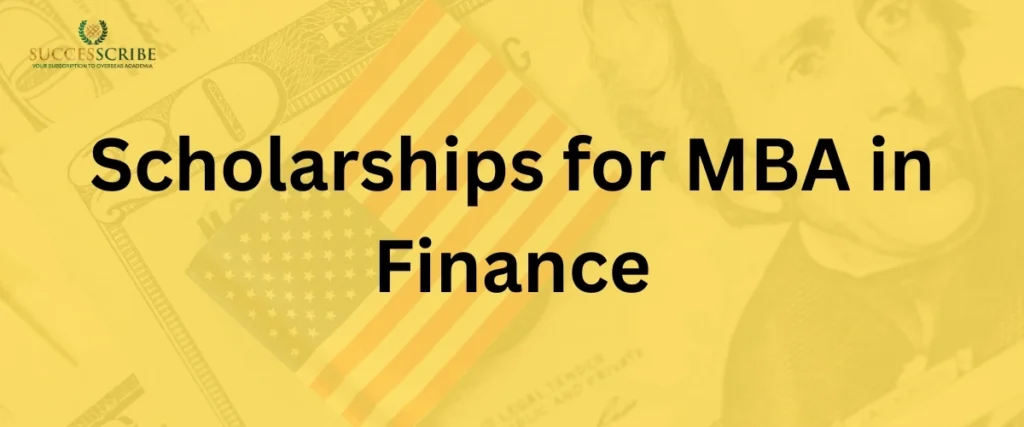An MBA in Finance in the USA is one of the most sought-after degrees for students aspiring to build a career in the financial sector. The USA is home to some of the world’s top business schools, offering cutting-edge curricula, excellent faculty, and unparalleled networking opportunities. This topic provides a detailed overview of the MBA in Finance in USA, covering tuition fees, top universities, admission requirements, scholarships, salary expectations, and more.
Top 11 Colleges for MBA in Finance in USA?

With an MBA in Finance in USA, graduates can secure high-paying roles in multinational banks, consulting firms, and private equity companies. The following institutions consistently rank among the top for finance specialization in their MBA programs:
| University / College Name | MBA Program Name | Average Finance Grad Salary | Unique Finance Advantage |
| New York University (Stern School of Business) | MBA in Finance | $168,000+ | Prime Wall Street location; best for investment banking |
| University of Pennsylvania (Wharton) | MBA with Major in Finance | $175,000+ | Top recruiting for investment banking & private equity, Wharton Finance Club, largest alumni network in finance |
| University of Chicago (Booth School of Business) | MBA with Concentration in Analytic Finance | $172,000+ | Best quantitative finance program; top for hedge funds |
| Columbia University (Columbia Business School) | MBA with Finance Focus | $165,000+ | Only Ivy League with Value Investing Program |
| Harvard University (Harvard Business School) | MBA (Finance electives available) | $158,000+ | Excellent for leadership roles in finance, access to top-tier VC and PE firms |
| Massachusetts Institute of Technology (Sloan School of Management) | MBA with Finance Track | $160,000+ | Best fintech/quant combination; STEM-designated |
| University of California, Berkeley (Haas School of Business) | MBA in Finance | $157,000+ | Proximity to Silicon Valley for fintech, focus on sustainable finance |
| University of Michigan (Ross School of Business) | MBA with Finance Concentration | $152,000+ | Strong placement in corporate finance & IB, real-world finance lab experience |
| Duke University (Fuqua School of Business) | MBA with Finance Concentration | $150,000+ | Known for collaborative learning, strong placement in healthcare finance & IB |
| Carnegie Mellon University (Tepper School of Business) | MBA in Finance | $148,000+ | Tech + finance focus, great for quant roles and data-driven finance |
| Ohio State University (Fisher College of Business) | MBA in Finance | $138,000+ | Affordable tuition with strong outcomes in regional banking & corporate finance |
Also Check: MBA in business analytics in USA
For more: MBA colleges in USA
Second-Tier Elite Finance Programs
Several other institutions offer exceptional finance MBA programs with strong placement records:
- UCLA Anderson School of Management
- Cornell University (Johnson)
- University of Michigan (Ross)
- Duke University (Fuqua)
- University of Virginia (Darden)
- Carnegie Mellon University (Tepper)
- Georgetown University (McDonough)
- Boston College (Carroll)
- University of Texas at Austin (McCombs)
- Washington University in St. Louis (Olin)
What is the Eligibility and Requirements to Study MBA in Finance in the USA

Choosing to do an MBA in Finance in USA is a strategic move for anyone aiming to lead in global financial markets. To secure admission into a top US MBA Finance program, applicants must meet the following criteria:
Academic Requirements
- A bachelor’s degree (preferably in finance, business, or economics) from an accredited institution.
- A minimum GPA of 3.0 – 3.5 (varies by university).
Entrance Exams
- GMAT Score: 650-740 for top universities
- GRE Score: 320+ (if accepted as an alternative to GMAT)
- IELTS: 7.0+ (for non-native English speakers)
- TOEFL: 100+ (for non-native English speakers)
Work Experience
- Most top business schools prefer 2-5 years of professional experience, though some accept fresh graduates.
Other Requirements
- Strong Letters of Recommendation (LORs)
- Well-written Statement of Purpose (SOP) or Essays
- Resume or CV highlighting professional achievements
- Interview (in some cases)
Also Check: MBA in business analytics in USA
Common Prerequisites for Finance Specialization
- Quantitative Background: Coursework or demonstrated proficiency in calculus, statistics, and economics
- Financial Knowledge: Basic understanding of accounting, corporate finance, and financial markets
- Computer Skills: Proficiency in Excel and statistical software programs
Tuition Fees at Top Business Schools For MBA in Finance in USA

Here are the tuition fees at top business schools for MBA in Finance in USA:
| University | Annual Tuition | Total Program Cost |
| Harvard Business School | $76,500 | $223,000 |
| Stanford GSB | $77,376 | $231,672 |
| Wharton | $80,432 | $243,768 |
| Chicago Booth | $77,841 | $237,520 |
| Columbia Business School | $79,116 | $232,465 |
| MIT Sloan | $78,954 | $241,692 |
| NYU Stern | $79,822 | $239,466 |
| Yale SOM | $76,770 | $224,800 |
| Berkeley Haas | $72,242 (in-state); $77,544 (out-of-state) | $217,000 |
Also Read: Masters in economics in USA
Annual Living Expenses by Location
Living Cost varies from city to city
| City | Total Annual |
| New York | $41,500-54,900 |
| Boston | $32,600-44,600 |
| Chicago | $28,800-42,000 |
| Philadelphia | $30,000-42,000 |
| San Francisco | $40,900-60,700 |
| Los Angeles | $34,400-54,400 |
Total Cost of Studying for MBA in Finance in USA
The total cost includes tuition fees + living expenses.
| Expense Type | Estimated Cost (Per Year) |
| Tuition Fees | 50,000–85,000 |
| Accommodation | 12,000–20,000 |
| Food & Transport | 8,000–15,000 |
| Health Insurance | 2,000–4,000 |
| Books & Supplies | 1,000–3,000 |
| Miscellaneous | 3,000–6,000 |
| Total | 76,000–133,000 |
Additional Cost
Here are the additional costs for MBA in Finance in USA
| Cost | Fees |
| Application Fees | $150-$275 per school |
| GMAT/GRE Testing | $275-$300 |
| TOEFL/IELTS | $200-$250 |
| Books and Supplies | $1,000-$2,500 per year |
| Technology Expense | $1,500-$3,000 |
| Student Activity Fees | $500-$2,000 per year |
| Networking Events/Travel | $2,000-$5,000 per year |
Also Read: Masters in digital marketing in USA
Scholarships for MBA in Finance in USA

Many scholarships can reduce your cost:
| Scholarship | Amount |
| Fulbright Foreign Student Program | Full tuition + living expenses |
| Harvard Business School Scholarships | Up to $40,000 per year |
| Stanford Knight-Hennessy Scholars Program | Full tuition + stipend |
| Forte Fellowship | Partial to full tuition |
| Wharton Fellowship Program | Varies (merit-based) |
| Yale SOM Merit-Based Scholarships | Varies |
Salary Expectations After MBA in Finance from USA

Graduates from top US business schools secure high-paying roles in:
| Job Role | Average Salary |
| Investment Banker | 150,000–250,000 |
| Financial Analyst | 90,000–130,000 |
| Private Equity Associate | 120,000–200,000 |
| Corporate Finance Manager | 110,000–160,000 |
| Risk Management Consultant | 100,000–150,000 |
| Risk Management | $130,000-$150,000 |
| Commercial Banker | $125,000-$140,000 |
Also Read: Masters in data science in USA
What is the Course Curriculum of MBA in Finance in USA

A typical 2-year MBA Finance program includes:
Many international students choose an MBA in Finance in USA due to its global credibility and strong alumni network. Finance MBA curricula typically blend core business fundamentals with specialized finance coursework.
Core MBA Curriculum (First Year)
- Financial Accounting: Understanding financial statements and accounting principles
- Corporate Finance: Capital structure, dividend policy, corporate governance
- Marketing Management: Marketing strategy and implementation
- Organizational Behavior: Leadership and management of organizations
- Operations Management: Process analysis and supply chain management
- Economics: Micro and macroeconomic principles for managers
- Strategy: Competitive advantage and industry analysis
Finance Specialization Courses (Second Year)
- Investment Analysis: Security valuation and portfolio management
- Financial Markets: Structure and operation of capital markets
- Derivatives and Risk Management: Options, futures, swaps
- Financial Modeling: Advanced Excel and financial simulation
- Mergers & Acquisitions: Deal structures, valuation, integration
- Private Equity and Venture Capital: Alternative investments
- Fixed Income Securities: Bond valuation and interest rate models
- International Finance: Global markets, exchange rates, international investments
- Behavioral Finance: Psychology of financial decision-making
- Fintech: Financial technology innovations and applications
Popular Finance Electives
- Value Investing: Graham and Dodd principles and application
- Hedge Fund Strategies: Analysis of various investment approaches
- Real Estate Finance: Property valuation and investment
- Entrepreneurial Finance: Funding startups and growth companies
- Financial Statement Analysis: Advanced accounting for investors
- Quantitative Trading: Algorithmic and systematic trading strategies
- Banking Regulation: Financial institution compliance and risk
- ESG Investing: Environmental, social, and governance considerations
- Blockchain in Finance: Cryptocurrency and distributed ledger applications
- Private Wealth Management: High-net-worth client advisory
Experiential Learning Components
- Investment Funds: Student-managed investment portfolios ($1-10M)
- Case Competitions: Inter-school finance challenges
- Finance Labs: Bloomberg terminals and other professional tools
- Internships: Summer positions at financial institutions
- Consulting Projects: Financial advisory for real clients
- Speaker Series: Industry leaders and alumni presentations
- Finance Clubs: Networking and skill development organizations
Also Read: Masters in cyber security in USA
MBA in Finance Without Work Experience
While most prestigious MBA programs prefer candidates with work experience, several options exist for recent graduates seeking to pursue finance MBAs without significant professional background:
Early Career MBA Programs
- Yale Silver Scholars Program: Designed specifically for students directly from undergraduate programs
- Harvard 2+2 Program: Deferred admission program that guarantees a spot after 2 years of work experience
- Stanford GSB Deferred Enrollment: Similar to Harvard’s program but for Stanford applicants
- MIT Sloan Early Career: Special consideration for exceptional recent graduates
Alternative Programs for Early Career Professionals
- Specialized Master’s in Finance: One-year programs focused exclusively on finance
- Master’s in Management (MIM): General business foundations for recent graduates
- Financial Engineering Programs: For quantitatively-focused students interested in computational finance.
Return on Investment Analysis
$175K+ average salary. 90% placement rate. The ROI of an MBA in Finance in USA speaks for itself.
| Items | Value |
| Total Investment (Tuition + Living) | $250,000-$300,000 |
| Opportunity Cost (2 years of pre-MBA salary) | $120,000-$180,000 |
| Total Cost | $370,000-$480,000 |
| Average Starting Salary | $150,000-$200,000 |
| Salary Growth (10-year cumulative) | $2,500,000-$3,500,000 |
| Pre-MBA Salary Growth (10-year estimation) | $1,200,000-$1,800,000 |
| Net Financial Gain (10-year) | $930,000-$1,700,000 |
| Breakeven Point | 4-5 years post-graduation |
Also Read: Masters in business analytics in USA
Top Reasons to Study MBA in Finance in USA

The United States offers several compelling advantages for international and domestic students pursuing an MBA in Finance:
- World-Class Education: US business schools consistently dominate global rankings, occupying 15 of the top 25 positions in the 2025 Financial Times Global MBA Rankings. Harvard Business School has maintained a top-5 position for 23 consecutive years, while Stanford GSB has achieved the #1 ranking 7 times since 2010. Wharton’s finance department employs 41 full-time faculty members-more than any other business school globally-with 87% holding doctoral degrees from elite institutions.
- Financial Industry Access: With Wall Street in New York (home to 3,200+ financial firms managing over $20 trillion in assets), the Chicago Mercantile Exchange (trading 4.5+ billion contracts annually), and San Francisco’s fintech ecosystem (securing $15.2 billion in venture funding in 2024), students gain proximity to financial powerhouses that represent 38% of global market capitalization.
- Advanced Curriculum: US MBA programs offer 3-4 times more specialized finance electives than European or Asian counterparts. At schools like MIT Sloan, 42% of finance courses incorporate AI and machine learning components. Columbia Business School offers 27 distinct finance electives, while Chicago Booth provides 19 different advanced quantitative finance courses that process live market data.
- Networking Opportunities: The extensive alumni networks of US business schools include 42,000+ Wharton graduates, 33,000+ Harvard MBAs, and 24,000+ Stanford GSB alumni holding C-suite positions in financial institutions across 124 countries. These networks host over 1,500 finance-specific alumni events annually and maintain 200+ city-specific alumni chapters worldwide.
- Research and Innovation: US schools produce 68% of all top-tier financial research publications. Faculty members hold 235+ patents related to financial technologies and algorithms. Harvard, Stanford, and Chicago Booth professors have received 5 Nobel Prizes in Economics since 2010, while 76 business school faculty members serve on Federal Reserve advisory councils.
- Career Outcomes: Finance MBAs from top-10 US schools report average starting base salaries of $175,300, with total first-year compensation reaching $276,500 when including signing bonuses ($37,200) and performance bonuses ($64,000). Investment banking associates from these programs receive an average of 4.3 job offers, with 94.2% of graduates securing positions within three months of graduation.
- OPT Benefits: The Optional Practical Training (OPT) program allows international students to work in the US for up to 12 months after graduation, with STEM-designated programs (now including 27 finance MBA programs) offering extensions up to 36 months. OPT approval rates exceed 97% for MBA graduates, with 76% of international finance MBAs securing US employment through this pathway.
- Diverse Peer Group: US MBA cohorts typically include students from 48+ countries on average, with international students comprising 37-42% of elite finance programs. Harvard Business School’s 2025 class includes finance professionals from 71 different countries, while Wharton’s MBA cohort speaks 58 languages and has work experience across 83 nations-providing global perspectives essential for understanding international financial markets.
International Student Considerations for MBA in Finance in USA
An MBA in Finance from the USA is a great choice for a high-paying global career. Top schools, strong job placements, and scholarships make it worth the investment.
Visa Process for MBA in Finance in USA
- F-1 Student Visa: Primary visa for full-time students
- I-20 Form: Issued by the university after acceptance
- SEVIS Fee: $350 for registration in student tracking system
- Visa Interview: At US embassy or consulate in home country
- Financial Documentation: Proof of funds for first year minimum
Post-Graduation Work Options
- Optional Practical Training (OPT): 12 months of work authorization
- STEM OPT Extension: Additional 24 months for eligible programs
- H-1B Visa: Employer-sponsored work visa (subject to annual lottery)
- O-1 Visa: For individuals with extraordinary ability
- Green Card Sponsorship: Permanent residency options
OPT/CPT Success Rate
- Approximately 98% of international MBA graduates obtain OPT approval
- About 70-75% of finance MBA international graduates find employment in the US during OPT period.
- Around 45-55% successfully transition to H-1B visas or other long-term work authorization.
Conclusion
If you’re looking to fast-track your career in finance, earn a globally respected degree, and open doors to high-paying opportunities, an MBA in Finance in USA might be the perfect choice for you. The combination of world-class education, strong industry ties, and excellent post-graduation prospects makes this degree one of the most valuable investments you can make in your future.
FAQs
What is the average salary after completing an MBA in Finance from the USA?
Graduates from top-tier US business schools can expect an average base salary between $150,000 to $200,000, with additional bonuses ranging from $30,000 to $100,000 depending on the industry (investment banking, private equity, fintech, etc.).
Can international students apply for scholarships for an MBA in Finance in the USA?
Yes, many US business schools offer merit-based and need-based scholarships to international students. For example, Stanford GSB offers up to $80,000, and Wharton provides fellowships ranging from $20,000 to full tuition.
Are MBA in Finance programs in the USA STEM-designated?
Yes, many top business schools offer STEM-designated MBA tracks, especially those with quantitative or finance-focused curricula. STEM designation allows for up to 36 months of OPT (Optional Practical Training) for international students.
How can I improve my chances of getting into a top MBA Finance program?
Here are some key tips :
1. GMAT 700+
2. Strong essays & recommendations
3. Internships/finance-related work
4. Networking with alumni
5. Apply in Round 1 (early)
Which companies hire MBA Finance graduates in the USA?
Top recruiters:
1. Investment Banks: Goldman Sachs, JPMorgan
2. Consulting Firms: McKinsey, BCG, Bain
3. Tech/FinTech: Google, PayPal, Stripe
Related Post
Masters in project management in USA
Masters in marketing in USA
Masters in international business in USA
Masters in interior design in USA















